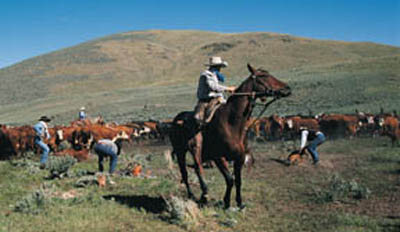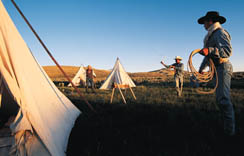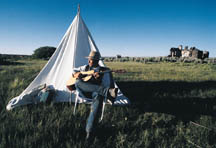|
|
|
| Subscriptions click here for 20% off! | E-Mail: info@rangemagazine.com |
|
It is late May, time to go to the outside country SPANISH RANCH
|
|||||||||||
|
|||||||||||
|
It’s late spring on the huge Spanish Ranch but I still remember those below-zero winter mornings of not too long ago. As we rode out across snow-covered meadows we saw billions of tiny ice particles suspended in the frigid air, each reflecting silver or gold or rainbow colors in the morning sunlight. Now these same meadows are lush and green, teeming with flocks of birds of many different species. These meadows would not be here now if not for enterprising men who cleared, leveled and irrigated thousands of acres of land to pasture cattle over 100 years ago. The best time at the Spanish Ranch is when the wagon pulls out in the middle of May, headed for the “outside” country. Loaded with bedrolls, teepees and groceries to begin the spring branding, the wagon we use is an old army truck set up inside with a small kitchen and “dining” area. This meals-on-wheels is operated by a vanishing breed of man who has an affinity for living with and cooking for a bunch of wayward buckaroos. Our six-man crew has our hands full. We spend the next few months out with the wagon, branding calves daily in the rugged Tuscarora Mountains close to the Idaho line. It is on the western edge of the Owyhee Desert and along the south fork of the Owyhee River in northeast Nevada. A part of the Great Basin, which covers southeastern Oregon, southern Idaho and northern Nevada, cowboys here are called “buckaroos,” derived from the Spanish word vaquero, which means “horseman.” Longer ropes are used by buckaroos–usually between 50 and 70 feet in |
|||||||||||
|
|||||||||||
|
length.We don’t tie “hard and fast” like Texas cowboys but dally on saddle horns wrapped with mule hide instead of rubber. We call it mule hide but it’s actually just a strip of chrome-tanned cowhide. The idea is to let your rope slide on that horn wrap, making it a little easier on your horse and the animal you are trying to catch. There’s plenty of roping to be done at branding time and buckaroos like to rope, a lot. If a guy is good at it he gains respect from the rest of the crew. The wagon is moved to the first camp at Four Mile Creek, while the cavvy of 50 horses is trailed due west about 30 miles along the Owyhee River and up a steep draw to meet it there. Buckaroo days start early and by 3:30 a.m., each man has left the “comfort” of his teepee for breakfast, and is soon ready to saddle up and ride. In this outfit, a “lucky” buckaroo or two might have to go for a bronc ride first because many of the horses are green. The rest of us whoop and holler to give the rider some moral support. If he stays in the saddle, fine, but if he gets bucked off unhurt, he’ll get ribbed. Either way, we’re off at a trot to make our circle for the morning’s branding. A circle might cover 10 or 15 square miles but we may have to trot for an hour or two just to get to where our circle will start. We take a chunk of country and divide it like a cake, each man taking a piece and pushing cattle to a branding trap in the middle. A couple of punchers carry the irons tied behind their saddles so if something unexpected happens, the irons won’t all get lost together. No pickups, no propane tanks here. We put the irons in a sagebrush fire. It’s quiet, it burns hot and there is plenty of fuel. As the calves are heeled and dragged to the fire, cowboys attack them like sharks at feeding time at the aquarium. At this time they are branded, ear marked, waddled, castrated, dehorned and vaccinated. After the wagon had been out for several weeks, I remember camping at Winters. My circle was in the grassy high country. It was a blue-sky morning, the air thick with the scent of yellow |
|||||||||||
|
|||||||||||
|
flowers that carpeted the top of the mountain. Small birds were skittering in the brush. Raptors rode the thermals. I could see for miles, out across the Owyhee Desert where our neighbors at the IL Ranch run their cattle. There are plenty of deer and antelope in this country and I’ve even seen a mountain lion or two. And there is no shortage of mustang on this outfit either. I once watched two stallions in combat, standing on hind legs, pawing and biting each other in a battle for control of the mares. It was an awesome sight. Wild horses do some strange things, too. One time I was pushing a few dozen wild steers that were quite a way ahead of me. I trotted up closer to keep an eye on them and found some running back toward me. Others were going in circles and figure eights, kicking up a pile of dust. It turned out that there was a black mustang stud in that dust cloud that wanted to have a little fun by chasing my steers to every point on the compass. After a while he quit his game and wandered off, so I gathered my steers and continued on to our gathering place. There is plenty of wildlife on the Owyhee Desert now but when the first explorers came through this country long ago, they found little game and almost starved to death. When cattlemen came here they increased the amount of life that the land could sustain by improving the waters, selecting sites that would collect precipitation and digging natural holes out deeper to last into the dry months. One day we had a fair amount of cattle gathered, for this country–maybe 50 or 80 calves to brand. I’m not sure, really, because we didn’t get to finish due to an accident. This time it was Gonzalo, the buckaroo boss. Because of a violent kick from a big calf, he got himself a serious knife wound to the chest at the branding fire. It didn’t keep him down for long though. A week-and-a-half later I saw him make one pretty tough bronc ride with that hole still in him. Late in the afternoon when branding is done for that day and we’re back at camp, someone will wrangle horses–bring them in from the temporary pasture to a holding pen–and we’ll select our mounts for the next day. The horses line up on a staked-out rope in a semicircle, tails pointed to the center, and they wait. The cowboss comes in behind them and catches a horse for each man, throwing a backhand loop called a hoolihan. When each of us has our pick for the next day, the cavvy is let loose again. After that a horse or two might get shod because every cowboy is responsible for taking care of his own string. A buckaroo’s string is usually six or seven horses, sometimes more if he’s training a few colts. When we’ve branded everything we can find on one area, we break camp and move the wagon and the cavvy. And on it goes until every square mile of the Spanish Ranch has been trotted upon. Well, it has been some time since the spring wagon finished up and came back home. Right now the buckaroos are sitting around the bunkhouse with the knowledge that tomorrow they’re going to get to experience those little tiny ice crystals floating all around them again. Not only is it cold but most of the old crew have moved on. We have a new buckaroo boss now. Jake Brown is a competent and well-known fellow in these parts and though not very old, he kind of reminds me of those old-time buckaroo bosses that you dared not do anything to get them tweaked at you. I’d like to come back in 30 years just to see how cranky he gets. I’m just kidding, Jake! I don’t need any bad horses added to my string. |
|||||||||||
|
To Subscribe: Please click here or call 1-800-RANGE-4-U for a special web price Copyright © 1998-2005 RANGE magazine For problems or questions regarding this site, please contact Dolphin Enterprises. last page update: 04.03.05 |



